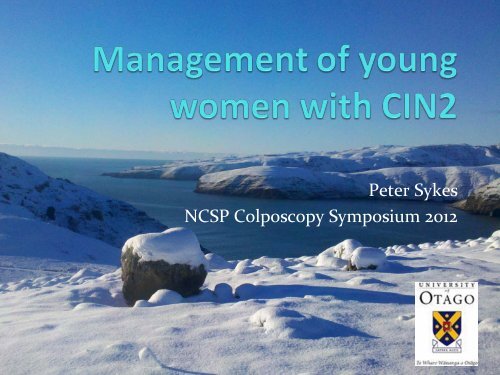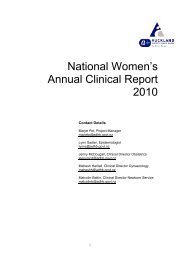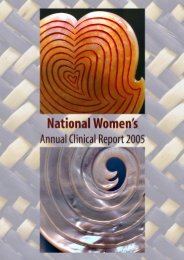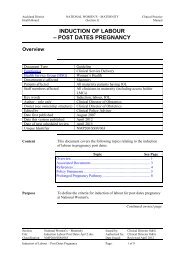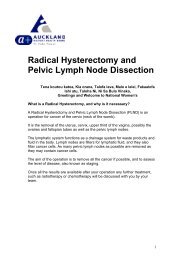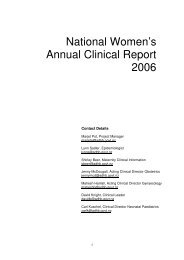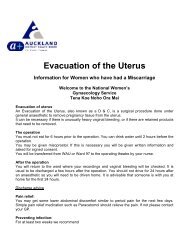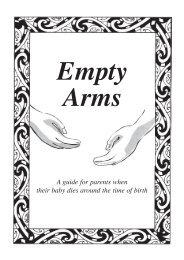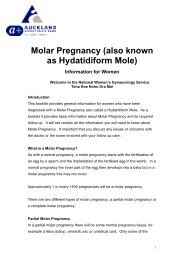Is there a place for conservative management of CIN2? - National ...
Is there a place for conservative management of CIN2? - National ...
Is there a place for conservative management of CIN2? - National ...
Create successful ePaper yourself
Turn your PDF publications into a flip-book with our unique Google optimized e-Paper software.
Peter Sykes<br />
NCSP Colposcopy Symposium 2012
A prospective trial <strong>of</strong> <strong>conservative</strong><br />
<strong>management</strong> in young women with<br />
• Predicting<br />
• Regression<br />
• In<br />
• CIN<br />
• E<br />
• 2<br />
• S<br />
<strong>CIN2</strong>.<br />
• Inclusion Criteria<br />
• Age under 25 at first visit.<br />
• No prior high grade histological or<br />
cytological abnormality prior to this<br />
referral.<br />
• Biopsy proven CIN 2.<br />
• Entire lesion accessible to colposcopy.<br />
• Participants in study agree to six<br />
monthly colposcopy and cervical smear<br />
and biopsy <strong>for</strong> a total <strong>of</strong> two years.<br />
• Cytology and pathology reviewed at<br />
multidisciplinary meeting. ( no suspicion<br />
<strong>of</strong> glandular abnormality biopsy<br />
consistent with cytology)<br />
• Signed in<strong>for</strong>med consent.
Aims /outcome measures<br />
Study Aims<br />
•To document the safety <strong>of</strong> follow‐<br />
up <strong>of</strong> CIN 2 in young women under<br />
the age <strong>of</strong> 25. (550)<br />
•To identify the rate <strong>of</strong> regression <strong>of</strong><br />
CIN 2 in this group <strong>of</strong> women.<br />
•To identify predictors <strong>of</strong> regression<br />
and progression <strong>of</strong> CIN 2 in this<br />
cohort.<br />
Primary outcome measures<br />
•Proportion whose lesions regress to<br />
CIN1 and normal within 24 months<br />
<strong>of</strong> follow up.<br />
•Proportion who are lost to follow up<br />
(greater than 9 months) during the<br />
study.<br />
Secondary outcome measures<br />
• Proportion <strong>of</strong> study participants<br />
who require treatment during 24<br />
month period<br />
• The reason treatment is required.<br />
• The proportion <strong>of</strong> the eligible<br />
women included in the study and<br />
reasons <strong>for</strong> exclusion<br />
• Correlation <strong>of</strong> clinical factors with<br />
regression<br />
• Correlation <strong>of</strong> cytology/pathology<br />
factors with regression,<br />
• Correlation <strong>of</strong> above factors and<br />
requirement <strong>for</strong> treatment (<strong>for</strong><br />
CIN3 or worse).
• In<strong>for</strong>med consent<br />
• Exclusion criteria<br />
• Multidisciplinary review<br />
• More than one biopsy<br />
• 2 addresses<br />
• Careful follow up<br />
• SAE <strong>for</strong>ms<br />
• Study monitoring<br />
• Stopping rules<br />
• Long term FU as per NCSP<br />
guidelines (previous HG)<br />
safety
• Peter Sykes, Bryony<br />
Simcock<br />
• Dianne Harker<br />
• Helene Mcnabb<br />
Christchurch<br />
• Simone Petrich Duneidin<br />
• Viki Robertson, Grey Hosp<br />
• Narena Dudley, Hamilton<br />
• Jim Faherty Invercargil<br />
• Dean Maharaj /Dianne<br />
Kenwright wellington<br />
• Lynn Sadler<br />
Multicenter study<br />
• <strong>National</strong> Womens,<br />
Middlemore, Hawkes Bay,<br />
Nelson/Bleneim. Royal<br />
Womens Melbourne<br />
• Cancer society grant
• Important<br />
study.<br />
• we would like<br />
to enrol our<br />
patients.<br />
• The treatment<br />
<strong>of</strong> <strong>CIN2</strong> in a 22<br />
year old<br />
woman is<br />
criminal.<br />
• <strong>CIN2</strong> should be<br />
considered Low<br />
grade<br />
controversia<br />
l<br />
• Ill conceived<br />
• A risk to patients<br />
• <strong>CIN2</strong> does not<br />
exist<br />
• <strong>CIN2</strong>/3 should be<br />
considered one<br />
entity<br />
• Diagnosis non<br />
reproducible<br />
• Too much work<br />
• Stressful <strong>for</strong><br />
women
How did we get here<br />
• Known regression <strong>CIN2</strong><br />
• Recognition <strong>of</strong> harm from treatment<br />
• <strong>CIN2</strong> Frequent diagnosis in young nulliparous<br />
women<br />
• Low incidence Cancer in young women<br />
• Limited efficacy <strong>of</strong> screening in young women<br />
• Conservative <strong>management</strong> in adolescent women<br />
• Increasing practice <strong>of</strong> <strong>conservative</strong> <strong>management</strong>
NCSP independent monitoring report<br />
july‐dec 2009
Adverse pregnancy outcomes associated with treatment CIN<br />
3. Adjusted odds ratios (95% CI) <strong>for</strong> the association between cervical procedures and extremely, very, and moderate spontaneous preterm delivery<br />
Variable<br />
All<br />
deliveries<br />
(n) a<br />
Extremely pretermb (n =<br />
1373)<br />
n<br />
Odds ratio e<br />
(95%)<br />
Very pretermc (n = 1665)<br />
n<br />
Odds ratio e<br />
(95%)<br />
Moderately pretermd (n =<br />
16,011)<br />
n<br />
Odds ratio e<br />
(95%)<br />
LEEP vs no<br />
LEEP<br />
No LEEP 544,498 1323 1.00 1596 1.00 15,600 1.00<br />
LEEP 8,180 50<br />
3.16 (2.27-<br />
4.40)<br />
69<br />
3.28 (2.56-<br />
4.19)<br />
411<br />
1.89 (1.71-<br />
2.09)<br />
Selected<br />
procedures<br />
vs no<br />
procedures<br />
No<br />
procedure<br />
510,841 1212 1.00 1465 1.00 14,429 1.00<br />
Biopsy 31,630 105<br />
1.28 (1.00-<br />
1.64)<br />
120<br />
Ablation 2,027 6<br />
1.20 (0.44-<br />
3.29)<br />
11<br />
LEEP 8,180 50<br />
3.23 (2.32-<br />
4.50)<br />
69<br />
Noehr. LEEP and spontaneous preterm delivery.<br />
Am J Obstet Gynecol 2009. a N = 552,678;<br />
1.32 (1.09-<br />
1.60)<br />
1.91 (1.05-<br />
3.47)<br />
3.37 (2.63-<br />
4.30)<br />
1093<br />
78<br />
411<br />
1.27 (1.19-<br />
1.35)<br />
1.35 (1.08-<br />
1.70)<br />
1.93 (1.74-<br />
2.14)<br />
e adjusted <strong>for</strong> calendar time, maternal age at delivery, smoking during pregnancy, and marital<br />
status during pregnancy.
Perinatal mortality and other severe adverse pregnancy outcomes<br />
associated with treatment <strong>of</strong> cervical intraepithelial neoplasia:<br />
meta‐analysisBMJ;337:a1284
Very low risk <strong>of</strong> cancer under the age <strong>of</strong> 25
Screening in women under 25 not<br />
associated with decreased incidence <strong>of</strong><br />
cervical cancer.<br />
P Sasieni BMJ 2009;339:b2968
Regression <strong>of</strong> <strong>CIN2</strong><br />
authour date Regression rate Age range Time period number<br />
Moscicki<br />
AB<br />
2010 62% 13‐24 2 yrs 95<br />
Guedes AC 2007 42% 1yr 45<br />
Monteiro 2010 58% 11‐19 2yr 17<br />
Moore k 2007 65% 13‐21 1.5 yr 23<br />
Discacciati<br />
M<br />
2011 74% 17‐47 1 yr 42<br />
Fuchs K 2007 50% 11‐20 2yr 36<br />
Castle P* 2009 40% 2yr 357*
NZ retrospective study<br />
Objective:<br />
• To review the outcome <strong>of</strong> (CIN) 2 in women under 25<br />
managed <strong>conservative</strong>ly.<br />
Study Design:<br />
• Multicenter<br />
retrospective review. Women with biopsy<br />
proven <strong>CIN2</strong> between 2005 and 2009.<br />
• Analysis comparing women who had immediate treatment<br />
with those whose treatment was deferred more than 4<br />
months.<br />
• The primary outcome measure was spontaneous<br />
regression <strong>of</strong> <strong>CIN2</strong>.<br />
• Secondary outcomes were treatment rates and loss to<br />
follow‐up.<br />
McAllum B, Sykes PH, Sadler L, Macnab H, Simcock BJ, Mekhail AK. <strong>Is</strong> the<br />
treatment <strong>of</strong> CIN 2 always necessary in women under 25 years old? Am J Obstet Gynecol. 2011 Nov;205(5):478.e1‐7.
findings<br />
• 452 women under 25 with <strong>CIN2</strong><br />
• Median age 21<br />
• 256 (57%) received immediate treatment,<br />
• 157 (35%) <strong>conservative</strong> <strong>management</strong><br />
• Median follow up 8 months<br />
• 39 (9%) <strong>management</strong> was unknown.<br />
• Younger nulliparous women more likely to be<br />
managed conservativly
Immediate treatment 256<br />
histology 232<br />
• Median time to treatment was 2 months.<br />
• Treatment histology <strong>CIN2</strong> 44%,<br />
• Normal 2.5%, CIN1 /HPV 20%<br />
• CIN3 (28%).<br />
• 2 cases were AIS<br />
• 1 case <strong>of</strong> 1a1 microinvasive squamous cancer.
Conservative <strong>management</strong> greater<br />
than 4 months<br />
Final histology/cytology<br />
• Normal 35%<br />
• CIN1/HPV 27%<br />
• <strong>CIN2</strong> 20%<br />
• CIN3 18%<br />
Median time to treatment 7 months (41%)<br />
• Lost to follow up 3%<br />
Smoking status and referral<br />
smear not associated with<br />
regression
There is a need <strong>for</strong> large multicenter prospective<br />
studies prior to the incorporation <strong>of</strong> <strong>conservative</strong><br />
<strong>management</strong> into common practice.<br />
• In a prospective manner what proportion <strong>of</strong> <strong>CIN2</strong> lesions<br />
will regress under <strong>conservative</strong> <strong>management</strong>?<br />
• What proportion <strong>of</strong> women will undergo <strong>conservative</strong><br />
<strong>management</strong>?<br />
• In a multicenter study what proportion <strong>of</strong> women will be<br />
lost to follow up?<br />
• <strong>Is</strong> <strong>there</strong> an identifiable risk to women?<br />
• Can we identify a group <strong>of</strong> women more likely to regress?<br />
• Does <strong>conservative</strong> <strong>management</strong> negatively impact on<br />
quality <strong>of</strong> life?<br />
• What are the cost implications <strong>of</strong> <strong>conservative</strong><br />
<strong>management</strong>?
Currently HPV status most predictive<br />
• 20/42 patients with HPV 16/18 showed early clearance<br />
• Of these, 90% had clearance <strong>of</strong> their CIN 2<br />
• But at least 50% <strong>of</strong> those with persistent HPV 16/18 had<br />
regression
What is <strong>CIN2</strong> ?<br />
P Castle
Biopsy correlates poorly with loop<br />
specimen<br />
P Castle
A pragmatic and simplistic view!<br />
CIN1<br />
•An acute viral<br />
infection<br />
•Likely to regress<br />
•Conservative<br />
<strong>management</strong><br />
recommended<br />
<strong>CIN2</strong><br />
CIN 3<br />
•Associated with<br />
persistent HPV<br />
infection.<br />
•Unlikely to<br />
regress<br />
•Associated with<br />
significant risk <strong>of</strong><br />
invasion<br />
•Treatment<br />
recommended
My opinion<br />
• Many young women with <strong>CIN2</strong>/ HSIL will undergo<br />
spontaneous regression.<br />
• Political risk to non screening in under 25s (7 cases<br />
2010/11).<br />
• Vaccination rates currently too low to have major<br />
impact<br />
• Currently <strong>conservative</strong> <strong>management</strong> <strong>of</strong> <strong>CIN2</strong> cannot<br />
be considered standard treatment.<br />
• Those wishing to <strong>of</strong>fer <strong>conservative</strong> <strong>management</strong><br />
should enrol patients in Princess.


